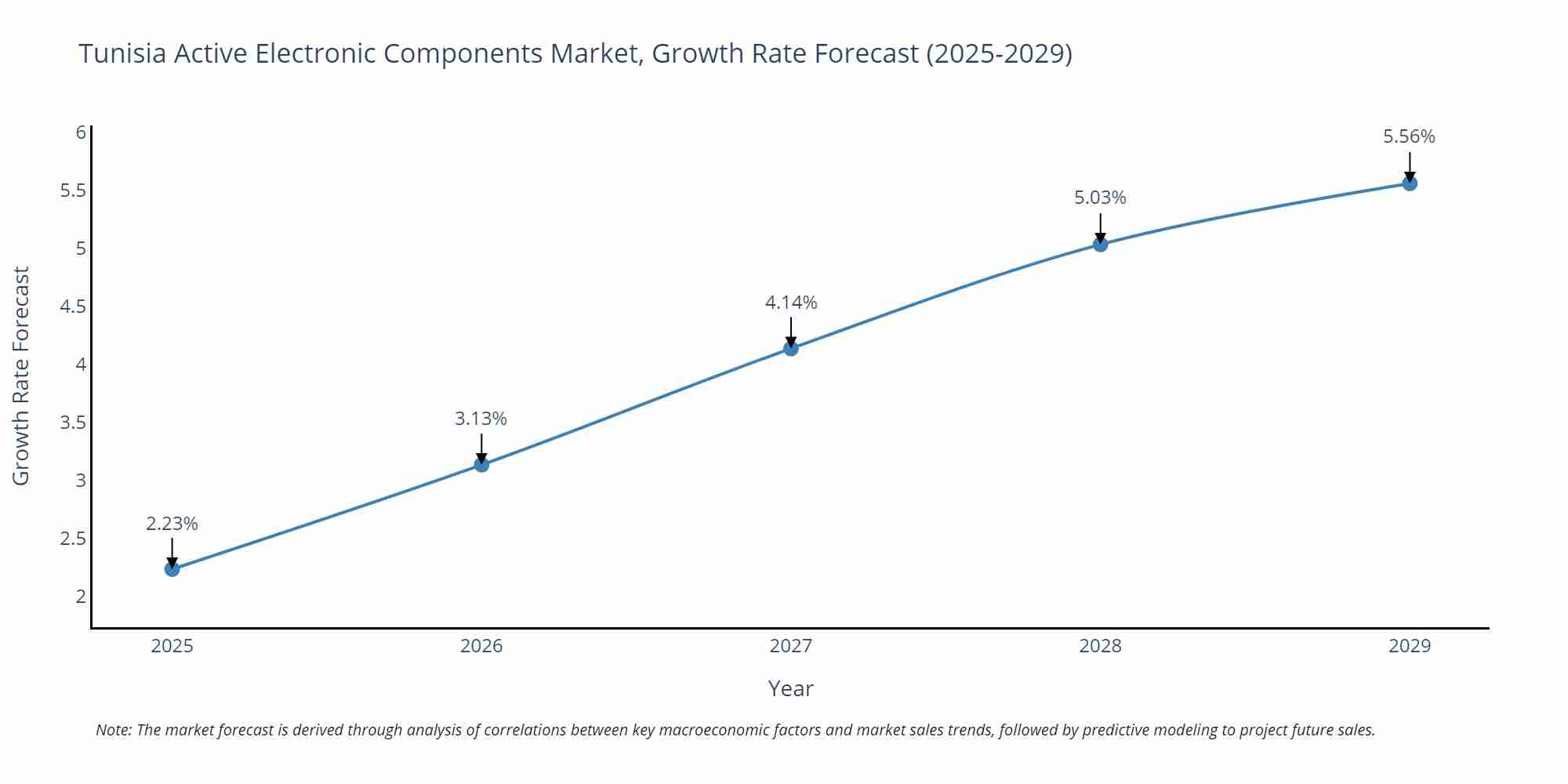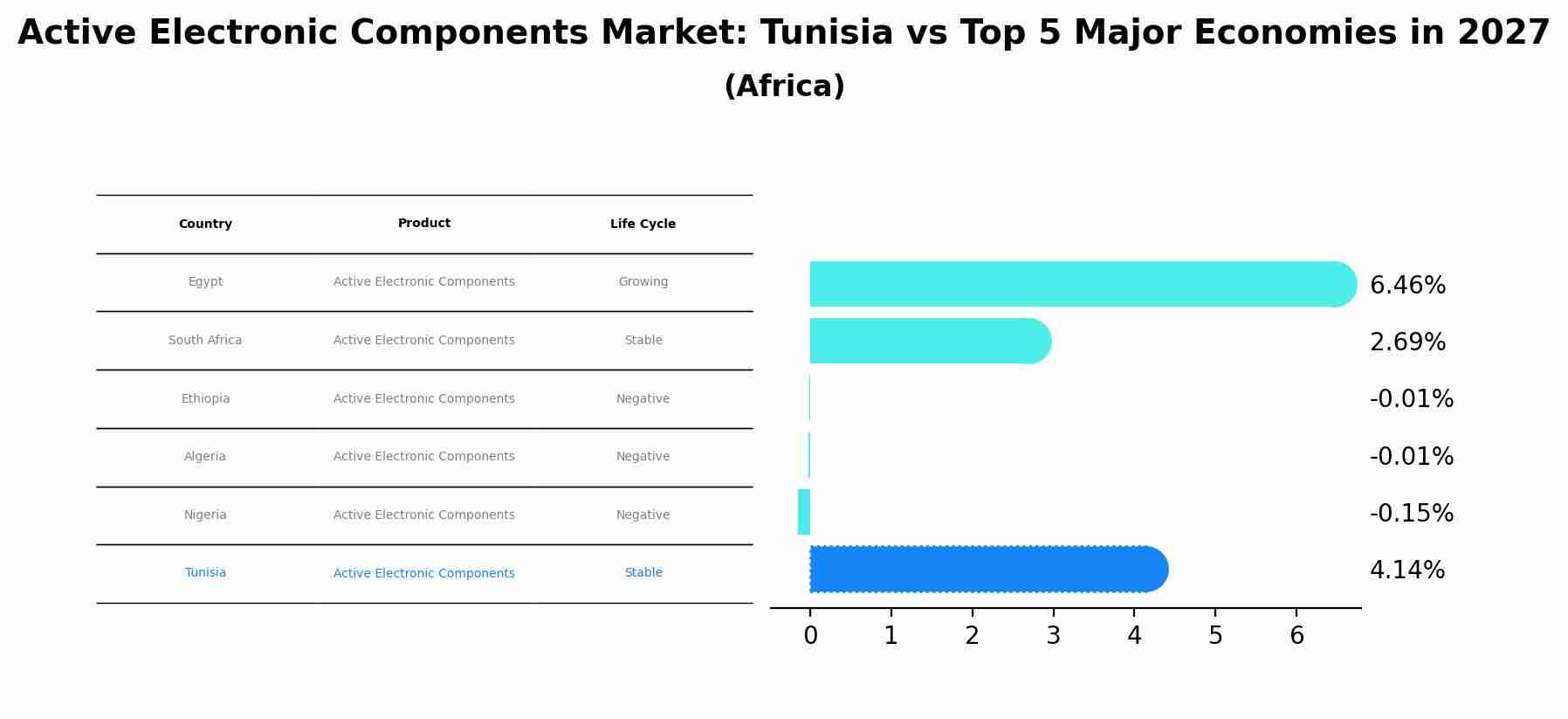Tunisia Active Electronic Components Market Outlook | Value, Share, Analysis, COVID-19 IMPACT, Growth, Revenue, Industry, Size, Companies, Trends & Forecast
| Product Code: ETC361434 | Publication Date: Aug 2022 | Updated Date: Jul 2025 | Product Type: Market Research Report | |
| Publisher: 6Wresearch | Author: Sumit Sagar | No. of Pages: 75 | No. of Figures: 35 | No. of Tables: 20 |
Tunisia Active Electronic Components Market Size Growth Rate
The Tunisia Active Electronic Components Market is likely to experience consistent growth rate gains over the period 2025 to 2029. From 2.23% in 2025, the growth rate steadily ascends to 5.56% in 2029.

Active Electronic Components Market: Tunisia vs Top 5 Major Economies in 2027 (Africa)
By 2027, the Active Electronic Components market in Tunisia is anticipated to reach a growth rate of 4.14%, as part of an increasingly competitive Africa region, where Egypt remains at the forefront, supported by South Africa, Ethiopia, Algeria and Nigeria, driving innovations and market adoption across sectors.

Tunisia Active Electronic Components Market Synopsis
The Tunisia Active Electronic Components Market is experiencing steady growth driven by factors such as the increasing demand for consumer electronics, telecommunications equipment, and automotive electronics. Key players in the market include international companies like STMicroelectronics and Texas Instruments along with local distributors. The market is characterized by a wide range of active electronic components such as semiconductors, integrated circuits, and diodes. The government`s focus on promoting the electronics industry through initiatives and investments is further fueling market growth. However, challenges like counterfeit products and fluctuations in raw material prices pose a threat to market expansion. Overall, the Tunisia Active Electronic Components Market presents opportunities for both local and international players to capitalize on the country`s growing electronics sector.
Tunisia Active Electronic Components Market Trends
In the Tunisia Active Electronic Components Market, several key trends are emerging. One major trend is the increasing demand for high-performance and energy-efficient components driven by the growing adoption of IoT devices and smart technologies across various industries. Another trend is the shift towards miniaturization and integration of components to meet the requirements of compact and portable electronic devices. Additionally, the market is witnessing a rise in demand for components with enhanced reliability and durability to ensure long-term performance and sustainability. Furthermore, advancements in semiconductor technology, particularly in areas such as AI and 5G, are influencing the development of active electronic components in Tunisia. Overall, these trends are shaping the market landscape and driving innovation in the active electronic components sector in Tunisia.
Tunisia Active Electronic Components Market Challenges
In the Tunisia Active Electronic Components Market, some key challenges faced include limited domestic production capacity, reliance on imports for a significant portion of electronic components, fluctuating currency exchange rates impacting import costs, and the presence of counterfeit products in the market. Additionally, the market is highly competitive, with a growing number of international players entering the space, putting pressure on local companies. Furthermore, there are concerns regarding intellectual property rights protection and regulatory compliance, which can add complexity and costs to operations. Overall, navigating these challenges requires companies in the Tunisia Active Electronic Components Market to focus on enhancing their manufacturing capabilities, establishing strong partnerships with reliable suppliers, and ensuring compliance with industry standards and regulations to maintain a competitive edge in the market.
Tunisia Active Electronic Components Market Investment Opportunities
The Tunisia Active Electronic Components Market presents various investment opportunities for growth and innovation. With the increasing demand for electronic devices and the rise of smart technologies, there is a growing need for active electronic components such as microcontrollers, integrated circuits, and power management chips. Investors can explore opportunities in manufacturing and supplying these components to meet the local and regional market demands. Additionally, investing in research and development to enhance the quality and efficiency of active electronic components can provide a competitive edge in the market. Collaborating with local electronics manufacturers and leveraging government initiatives to support the electronics industry can also be beneficial for investors looking to capitalize on the expanding market potential in Tunisia.
Jordan Agar Market Government Policies
The Tunisian government has implemented various policies to support the growth of the Active Electronic Components Market. These policies include providing incentives for companies to invest in research and development, promoting innovation in the sector, and fostering collaboration between industry players and academic institutions. The government also offers tax breaks and subsidies to encourage domestic production and attract foreign investment in the market. Additionally, there are regulations in place to ensure product quality, safety, and compliance with international standards. Overall, these policies aim to enhance competitiveness, drive technological advancements, and create a conducive environment for the growth of the Active Electronic Components Market in Tunisia.
Tunisia Active Electronic Components Market Future Outlook
The Tunisia Active Electronic Components Market is projected to experience steady growth in the coming years due to increasing demand for electronic devices across various industries such as automotive, telecommunications, and consumer electronics. The rapid technological advancements and the shift towards digitization are expected to drive the market further. Additionally, the growing adoption of IoT devices, automation, and artificial intelligence technologies will create new opportunities for active electronic component manufacturers in Tunisia. The market is likely to benefit from government initiatives to promote the electronics industry and attract foreign investments. However, factors such as supply chain disruptions, fluctuating raw material prices, and competition from global players may pose challenges to market growth. Overall, the Tunisia Active Electronic Components Market is poised for expansion with a positive outlook for the future.
Key Highlights of the Report:
- Tunisia Active Electronic Components Market Outlook
- Market Size of Tunisia Active Electronic Components Market, 2021
- Forecast of Tunisia Active Electronic Components Market, 2031
- Historical Data and Forecast of Tunisia Active Electronic Components Revenues & Volume for the Period 2018 - 2031
- Tunisia Active Electronic Components Market Trend Evolution
- Tunisia Active Electronic Components Market Drivers and Challenges
- Tunisia Active Electronic Components Price Trends
- Tunisia Active Electronic Components Porter's Five Forces
- Tunisia Active Electronic Components Industry Life Cycle
- Historical Data and Forecast of Tunisia Active Electronic Components Market Revenues & Volume By Product for the Period 2018 - 2031
- Historical Data and Forecast of Tunisia Active Electronic Components Market Revenues & Volume By Semiconductor Devices for the Period 2018 - 2031
- Historical Data and Forecast of Tunisia Active Electronic Components Market Revenues & Volume By Vacuum Tubes for the Period 2018 - 2031
- Historical Data and Forecast of Tunisia Active Electronic Components Market Revenues & Volume By Display Devices for the Period 2018 - 2031
- Historical Data and Forecast of Tunisia Active Electronic Components Market Revenues & Volume By Others for the Period 2018 - 2031
- Historical Data and Forecast of Tunisia Active Electronic Components Market Revenues & Volume By End-user for the Period 2018 - 2031
- Historical Data and Forecast of Tunisia Active Electronic Components Market Revenues & Volume By Consumer Electronics for the Period 2018 - 2031
- Historical Data and Forecast of Tunisia Active Electronic Components Market Revenues & Volume By Networking & Telecommunication for the Period 2018 - 2031
- Historical Data and Forecast of Tunisia Active Electronic Components Market Revenues & Volume By Automotive for the Period 2018 - 2031
- Historical Data and Forecast of Tunisia Active Electronic Components Market Revenues & Volume By Manufacturing for the Period 2018 - 2031
- Historical Data and Forecast of Tunisia Active Electronic Components Market Revenues & Volume By Aerospace & Defense for the Period 2018 - 2031
- Historical Data and Forecast of Tunisia Active Electronic Components Market Revenues & Volume By Healthcare for the Period 2018 - 2031
- Historical Data and Forecast of Tunisia Active Electronic Components Market Revenues & Volume By Others for the Period 2018 - 2031
- Tunisia Active Electronic Components Import Export Trade Statistics
- Market Opportunity Assessment By Product
- Market Opportunity Assessment By End-user
- Tunisia Active Electronic Components Top Companies Market Share
- Tunisia Active Electronic Components Competitive Benchmarking By Technical and Operational Parameters
- Tunisia Active Electronic Components Company Profiles
- Tunisia Active Electronic Components Key Strategic Recommendations
Frequently Asked Questions About the Market Study (FAQs):
- Single User License$ 1,995
- Department License$ 2,400
- Site License$ 3,120
- Global License$ 3,795
Search
Related Reports
- Portugal Electronic Document Management Market (2025-2031) | Strategy, Consumer Insights, Analysis, Investment Trends, Opportunities, Growth, Size, Share, Industry, Revenue, Segments, Value, Segmentation, Supply, Forecast, Restraints, Outlook, Competition, Drivers, Trends, Demand, Pricing Analysis, Competitive, Strategic Insights, Companies, Challenges
- France Electronic Document Management Market (2025-2031) | Strategy, Consumer Insights, Analysis, Investment Trends, Opportunities, Growth, Size, Share, Industry, Revenue, Segments, Value, Segmentation, Supply, Forecast, Restraints, Outlook, Competition, Drivers, Trends, Demand, Pricing Analysis, Competitive, Strategic Insights, Companies, Challenges
- Portugal Occupational Health & Safety Services Market (2025-2031) | Strategy, Consumer Insights, Analysis, Investment Trends, Opportunities, Growth, Size, Share, Industry, Revenue, Segments, Value, Segmentation, Supply, Forecast, Restraints, Outlook, Competition, Drivers, Trends, Demand, Pricing Analysis, Competitive, Strategic Insights, Companies, Challenges
- Netherlands Occupational Health and Safety Services Market (2025-2031) | Strategy, Consumer Insights, Analysis, Investment Trends, Opportunities, Growth, Size, Share, Industry, Revenue, Segments, Value, Segmentation, Supply, Forecast, Restraints, Outlook, Competition, Drivers, Trends, Demand, Pricing Analysis, Competitive, Strategic Insights, Companies, Challenges
- Belgium and Luxembourg Facility Management Market (2025-2031) | Strategy, Consumer Insights, Analysis, Investment Trends, Opportunities, Growth, Size, Share, Industry, Revenue, Segments, Value, Segmentation, Supply, Forecast, Restraints, Outlook, Competition, Drivers, Trends, Demand, Pricing Analysis, Competitive, Strategic Insights, Companies, Challenges
- Russia Women Intimate Apparel Market (2025-2031) | Strategy, Consumer Insights, Analysis, Investment Trends, Opportunities, Growth, Size, Share, Industry, Revenue, Segments, Value, Segmentation, Supply, Forecast, Restraints, Outlook, Competition, Drivers, Trends, Demand, Pricing Analysis, Competitive, Strategic Insights, Companies, Challenges
- Africa Chocolate Market (2025-2031) | Size, Share, Trends, Growth, Revenue, Analysis, Forecast, industry & Outlook
- Global Hydroxychloroquine And Chloroquine Market (2025-2031) | Industry, Trends, Size, Outlook, Growth, Value, Companies, Revenue, Analysis, Share, Forecast
- Saudi Arabia Plant Maintenance Market (2025-2031) | Industry, Size, Growth, Revenue, Value, Companies, Forecast, Analysis, Share & Trends
- Taiwan Electric Truck Market (2025-2031) | Outlook, Industry, Revenue, Size, Forecast, Growth, Analysis, Share, Companies, Value & Trends
Industry Events and Analyst Meet
Our Clients
Whitepaper
- Middle East & Africa Commercial Security Market Click here to view more.
- Middle East & Africa Fire Safety Systems & Equipment Market Click here to view more.
- GCC Drone Market Click here to view more.
- Middle East Lighting Fixture Market Click here to view more.
- GCC Physical & Perimeter Security Market Click here to view more.
6WResearch In News
- Doha a strategic location for EV manufacturing hub: IPA Qatar
- Demand for luxury TVs surging in the GCC, says Samsung
- Empowering Growth: The Thriving Journey of Bangladesh’s Cable Industry
- Demand for luxury TVs surging in the GCC, says Samsung
- Video call with a traditional healer? Once unthinkable, it’s now common in South Africa
- Intelligent Buildings To Smooth GCC’s Path To Net Zero













